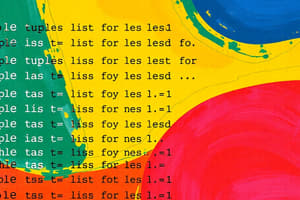Podcast
Questions and Answers
What is the result of the operation a[1:4] if a = [1, 2, 3, 4, 5]?
What is the result of the operation a[1:4] if a = [1, 2, 3, 4, 5]?
- [3, 4, 5]
- [2, 3, 4, 5]
- [2, 3, 4] (correct)
- [1, 2, 3]
Which of the following operations would create a new sequence that consists of the elements of b repeated three times if b = ['a', 'b', 'c', 'd']?
Which of the following operations would create a new sequence that consists of the elements of b repeated three times if b = ['a', 'b', 'c', 'd']?
- 3 * b (correct)
- b.repeat(3)
- b * 3 (correct)
- b + b + b
What will the expression len(a + b) return if a = [1, 2, 3, 4, 5] and b = ['a', 'b', 'c', 'd']?
What will the expression len(a + b) return if a = [1, 2, 3, 4, 5] and b = ['a', 'b', 'c', 'd']?
- 8 (correct)
- 10
- 5
- 9
If 6 in a evaluates to False, which of the following statements is accurate?
If 6 in a evaluates to False, which of the following statements is accurate?
What does the expression a[2:5:2] yield when a = [1, 2, 3, 4, 5]?
What does the expression a[2:5:2] yield when a = [1, 2, 3, 4, 5]?
What character is used in Python to create a new line within a string?
What character is used in Python to create a new line within a string?
Which of the following statements about Python sets is true?
Which of the following statements about Python sets is true?
How do you insert a double quote within a string in Python?
How do you insert a double quote within a string in Python?
Which of the following is the correct way to initialize an empty set in Python?
Which of the following is the correct way to initialize an empty set in Python?
What will be the output of the following code: print("Hello\nWorld")?
What will be the output of the following code: print("Hello\nWorld")?
What is the purpose of the escape character \t in a string?
What is the purpose of the escape character \t in a string?
After executing a = {1, 3.14, 'Some String'}; a.remove(3.14), what will the set 'a' contain?
After executing a = {1, 3.14, 'Some String'}; a.remove(3.14), what will the set 'a' contain?
What is the output of the code snippet: print("Here is a backslash character: ")?
What is the output of the code snippet: print("Here is a backslash character: ")?
What indicates that a tuple is being created with only one element?
What indicates that a tuple is being created with only one element?
What will be the output of the operation 'a + b' when a = ('a', 'b', 'c', 'd') and b = (1, 2, 3)?
What will be the output of the operation 'a + b' when a = ('a', 'b', 'c', 'd') and b = (1, 2, 3)?
Which of the following statements is true about tuples?
Which of the following statements is true about tuples?
What will the output of 'print(a[2:4])' be if a = ('a', 'b', 'c', 'd')?
What will the output of 'print(a[2:4])' be if a = ('a', 'b', 'c', 'd')?
How do negative indices function in Python?
How do negative indices function in Python?
What will happen if you attempt to assign a new value to an element of a tuple?
What will happen if you attempt to assign a new value to an element of a tuple?
In Python, which of the following best describes a list?
In Python, which of the following best describes a list?
Which of these is a valid way to define an empty tuple?
Which of these is a valid way to define an empty tuple?
What will the output of 'print(b*2)' be if b = ('a', 'b', 'c', 'd')?
What will the output of 'print(b*2)' be if b = ('a', 'b', 'c', 'd')?
What will 'print(a == (1, 2))' return if a = (1, 2, 3, 4)?
What will 'print(a == (1, 2))' return if a = (1, 2, 3, 4)?
What will be the result of the following expression: a[-1] where a = [1, 2, 3, 4, 5]?
What will be the result of the following expression: a[-1] where a = [1, 2, 3, 4, 5]?
Which of the following correctly demonstrates a mutable object assignment?
Which of the following correctly demonstrates a mutable object assignment?
What will the output of the following code segment be? l = [1, 2, 3]; l.append(0); l.insert(1, 5); print(l)
What will the output of the following code segment be? l = [1, 2, 3]; l.append(0); l.insert(1, 5); print(l)
How can you create a list of odd numbers between 1 and 100 using list comprehension?
How can you create a list of odd numbers between 1 and 100 using list comprehension?
Which of the following methods would remove the last element from the list?
Which of the following methods would remove the last element from the list?
What will the output be after executing the code: a = [1, 2, 3]; a.reverse(); print(a)?
What will the output be after executing the code: a = [1, 2, 3]; a.reverse(); print(a)?
Which of the following is NOT a method provided for list manipulation?
Which of the following is NOT a method provided for list manipulation?
Given the list a = ['a', 'b', 'c'], what will print(a[:-1]) yield?
Given the list a = ['a', 'b', 'c'], what will print(a[:-1]) yield?
What will be the value of b after executing the following code? a = [1, 2, 3]; b = a.copy(); a[0] = 10; print(b)
What will be the value of b after executing the following code? a = [1, 2, 3]; b = a.copy(); a[0] = 10; print(b)
Which syntax correctly removes an element at a specified index from a list?
Which syntax correctly removes an element at a specified index from a list?
What will the output be for the condition 'if (2,3,4) in (1,2,3,4,5)'?
What will the output be for the condition 'if (2,3,4) in (1,2,3,4,5)'?
Which string method returns the index of the first occurrence of a substring?
Which string method returns the index of the first occurrence of a substring?
What does the slice operation s1.rstrip() accomplish?
What does the slice operation s1.rstrip() accomplish?
What is the result of applying the function apply_operation(square, [1,2,3])?
What is the result of applying the function apply_operation(square, [1,2,3])?
When using the in operator with strings, which of the following is true?
When using the in operator with strings, which of the following is true?
What will be the output of the following code: print('These are "double quotes" within a single quote string.')?
What will be the output of the following code: print('These are "double quotes" within a single quote string.')?
Which of the following correctly uses the map function to square a list of numbers?
Which of the following correctly uses the map function to square a list of numbers?
What is returned by s1.count(s2)?
What is returned by s1.count(s2)?
Which operation is not valid for manipulating strings?
Which operation is not valid for manipulating strings?
If the string s is 'John Smith ', what will print(s.split(' ')) return?
If the string s is 'John Smith ', what will print(s.split(' ')) return?
Flashcards
String
String
A sequence of characters enclosed in single or double quotes. Example: 'Hello' or "World".
List
List
A sequence of objects. It's like a tuple, but you can change the elements within it.
Tuple
Tuple
A sequence of objects that cannot be changed after creation. Example: (1, 2, 3, 4).
Range
Range
Signup and view all the flashcards
Set
Set
Signup and view all the flashcards
Dictionary
Dictionary
Signup and view all the flashcards
Mutability
Mutability
Signup and view all the flashcards
Indexing
Indexing
Signup and view all the flashcards
Slicing
Slicing
Signup and view all the flashcards
Iteration
Iteration
Signup and view all the flashcards
Negative Indexing in Python Lists
Negative Indexing in Python Lists
Signup and view all the flashcards
Slicing with Negative Steps
Slicing with Negative Steps
Signup and view all the flashcards
Assignment by Reference
Assignment by Reference
Signup and view all the flashcards
Avoiding Mutable Object Assignment Issues
Avoiding Mutable Object Assignment Issues
Signup and view all the flashcards
List append() Method
List append() Method
Signup and view all the flashcards
List insert() Method
List insert() Method
Signup and view all the flashcards
List remove() Method
List remove() Method
Signup and view all the flashcards
List index() Method
List index() Method
Signup and view all the flashcards
List pop() Method
List pop() Method
Signup and view all the flashcards
List reverse() Method
List reverse() Method
Signup and view all the flashcards
seq[i]
seq[i]
Signup and view all the flashcards
seq1 + seq2
seq1 + seq2
Signup and view all the flashcards
seq[start:end:step]
seq[start:end:step]
Signup and view all the flashcards
a in seq
a in seq
Signup and view all the flashcards
n * seq
n * seq
Signup and view all the flashcards
What is a String?
What is a String?
Signup and view all the flashcards
How to use In Operator?
How to use In Operator?
Signup and view all the flashcards
What is a Range
What is a Range
Signup and view all the flashcards
What is Iteration?
What is Iteration?
Signup and view all the flashcards
What is Mapping?
What is Mapping?
Signup and view all the flashcards
String Method: find ()
String Method: find ()
Signup and view all the flashcards
String Method: count ()
String Method: count ()
Signup and view all the flashcards
String Method: replace ()
String Method: replace ()
Signup and view all the flashcards
String Method: rstrip ()
String Method: rstrip ()
Signup and view all the flashcards
String Method: split ()
String Method: split ()
Signup and view all the flashcards
Escape Character
Escape Character
Signup and view all the flashcards
add()
add()
Signup and view all the flashcards
remove()
remove()
Signup and view all the flashcards
Study Notes
Python Data Structures - Tuples
- Tuples are ordered, immutable sequences of items
- Items can be any data type (e.g., numbers, strings, other tuples)
- Defined using parentheses
()and commas to separate items - Creating a tuple with one element requires a comma after the element. e.g.
(1,) - Tuples are immutable; you cannot change elements after creation. Attempting to modify a tuple will result in a
TypeError - Accessed using index positions (starting at 0)
- Similar to strings, you can iterate over, slice or index them
Python Data Structures - Lists
- Lists are ordered, mutable sequences of items
- Items can be any data type (e.g., numbers, strings, other lists)
- Defined using square brackets
[]and commas to separate items - Lists are mutable, meaning you can change elements after they are created
- Accessed using index positions (starting at 0)
- Can be iterated over, sliced, and indexed in a similar way to tuples
Python Data Structures - Sets
- Sets are unordered collections of unique elements
- Items can be any hashable data type (numbers, strings, tuples, but not lists)
- Defined using curly braces
{}and commas to separate items - Sets do not allow duplicate elements.
- Elements aren't accessible by index; you must iterate over them
- Sets support various operations like union, intersection, difference, etc.
Python Data Structures - Dictionaries
- Dictionaries are unordered collections of key-value pairs
- Each key is unique and immutable (like keys in a real-world dictionary)
- Values can be any type
- Defined using curly braces
{}with key-value pairs separated by colons and items separated by commas - Accessed using keys, rather than indexes
- Mutability: Keys and values in a dictionary are mutable, allowing you to change the values associated with keys
Studying That Suits You
Use AI to generate personalized quizzes and flashcards to suit your learning preferences.




